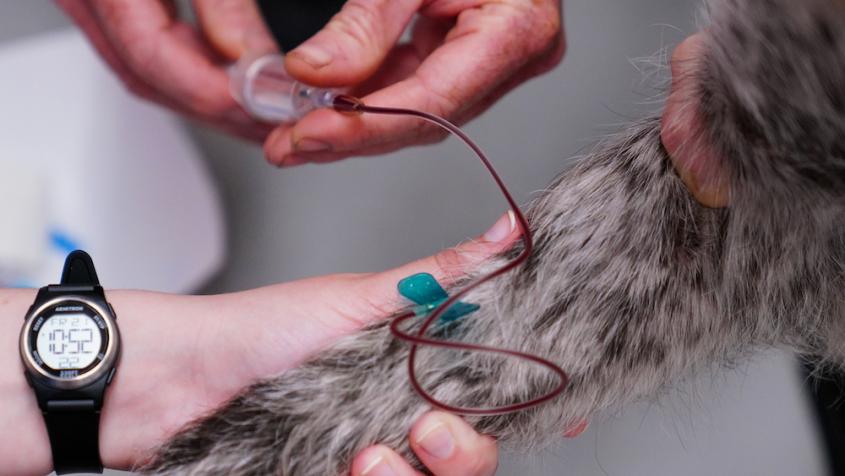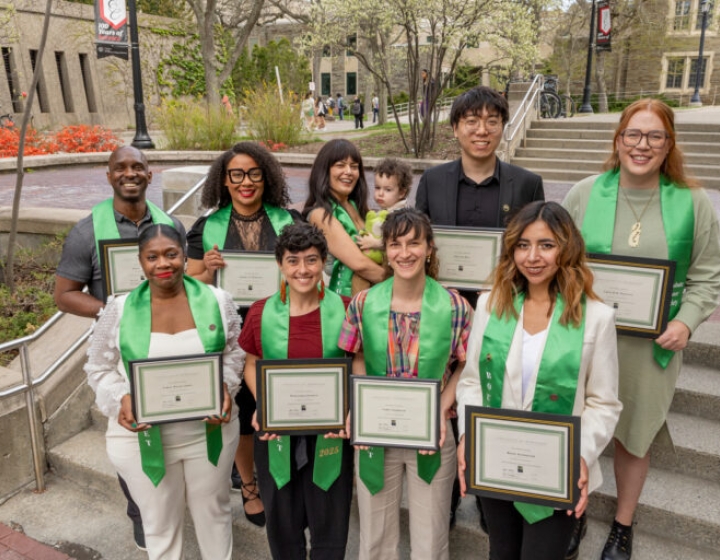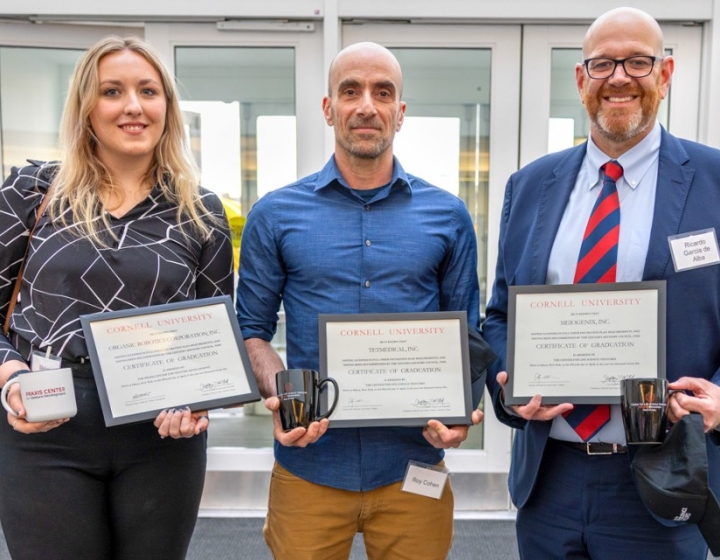Doggy donors, student volunteers help Cornell’s animal hospital expand its blood bank
There are only a handful of veterinary blood banks across the country, and those relative few are experiencing a national shortage. This makes obtaining blood a challenge for some animal hospitals that depend on their products.
For the veterinary blood bank program at the Cornell University Hospital for Animals (CUHA), relying on these already strained commercial services will soon be a thing of the past. The longstanding program is rapidly approaching a fully internal system of procuring blood products for the patients of CUHA, thanks to the help of local donors and a group of student volunteers.

“This is a huge, exciting step for our animal hospital,” says licensed veterinary technician specialist Carol Frederick. Frederick, alongside faculty liaison Dr. Galina Hayes, leads the blood donor program at CUHA, which was established over three decades ago with just a few dogs and cats.
“The pandemic has contributed to the shortage,” Hayes explains. “We have seen a recent rapid increase in caseload, for example, in our emergency room at CUHA — this year has a 35% increase compared with last. This has been coupled with staffing shortages at some of the external blood banks, limiting supply.”
A veterinary blood bank collects, tests and stores blood, and separates it into component parts — like red blood cells, platelets and various plasma products — for specialized use in certain procedures and therapies. Since the donated blood is processed on site without having to travel, products with a short shelf life, like platelet concentrate for example, are now available for patients whose blood can’t clot and need urgent platelet replacement due to immune disease or blood loss.
Licensed veterinary technician Deb Watrous led the program for 28 years. “By collecting and making our own blood products on site, we lessen the burden on blood banks, who can then offer more units to other practices for whom this may be their only option,” says Watrous, noting that not all veterinary practices can afford the specialized equipment or training for staff that’s required when taking blood donations, processing the units into component parts and offering blood component therapy.

Prior to CUHA’s recent growth, Watrous was on call to track down blood donors and coordinate with commercial blood banks to provide all of the hospital’s blood component needs. She handed off those duties to Frederick three years ago, and Hayes joined this February, prompting the program’s expansion.
This was enabled by the creation of a blood bank veterinary student volunteer group. “We have over 50 members who are a huge help with screening donors as well as the actual donations,” Hayes says. “They practice their communication skills by interacting with the owners of the donors, perform physical exams and practice venipuncture, and they provide the manpower essential to running the program. Everyone benefits.”
To create the blood bank, CUHA purchased a specialty, temperature-controlled refrigerator that keeps units at approximately 4 degrees Celsius. They also use a specialized centrifuge, an ultra-low freezer and other equipment and storage. Frederick regularly sends calls for new donor volunteers to the College of Veterinary Medicine (CVM) community to build the donor base, but welcomes volunteers from any source. Dogs must be between 1-5 years old, weigh at least 62 pounds, have a relaxed temperament and be available to donate every few months. All breeds are considered, but the program prefers greyhounds, boxers, Irish wolfhounds, German shepherds, Dobermann Pinschers and pit bulls.

“It’s heartening to see how many people want their animal to be involved,” Frederick says. “Our ultimate goal is to have approximately 50 dogs in the program so we can set up a routine schedule. That way we’re collecting blood proactively, not reactively.”
This makes life much easier for on-call staff, and provides better products for patients in need. Donors undergo a rigorous screening process and thorough bloodwork to ensure they’re healthy enough to donate and won’t inadvertently give the recipient anything harmful. All blood collected is for dedicated use in the hospital and won’t be sold elsewhere.
Volunteers get some perks in return. In addition to a free yearly physical exam, dogs receive free core vaccines, comprehensive bloodwork, a box of treats and dog food at every donation visit, a $20 credit on their next hospital bill and a year's worth of heartworm, flea and tick prevention. CUHA also created a vest for the animals to showcase their role as blood donors.
“The perks help us build the donor base, but they’re also to help the animals,” Frederick says. “On our end, we need to know these dogs are healthy enough to donate, so it’s a win-win.” Everybody gets a can of chicken when they’re done, she adds. “We want this to be a good experience for the dogs, too.”
“I wanted to allow my dogs to help others that needed blood. I would hope someone would do the same for my dogs,” says senior lecturer Jordyn Boesch, D.V.M. ’06, whose golden retrievers Rosie and Winnie participate in the program.

Boesch works on CUHA’s anesthesia and pain medicine service and has seen her dogs have a direct impact on the lives of ill animals at Cornell. “One of our technicians brought her beloved elderly dog into the emergency service. My dog Rosie’s blood was transfused into him, and this allowed him to stabilize enough that he could spend a few more precious days with his family,” says Boesch. “I was so gratified to learn that Rosie gave him and his whole family extra time together.”

Just like their CVM owners, these canine donors are doing their part to help provide compassionate care to animals in need at Cornell. Says Boesch. “We have phenomenal technicians and clinicians running the program, and it truly saves lives.”
If you would like to apply for your dog to become a donor, and it meets the above guidelines, please reach out to Frederick at c.frederick@cornell.edu.
Written by Melanie Greaver Cordova





